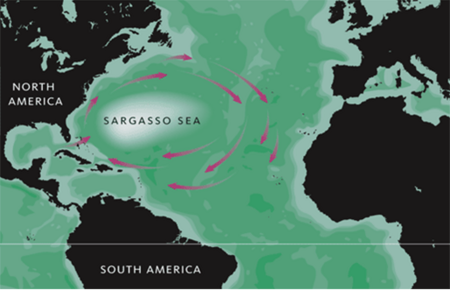Sargasso Sea: Difference between revisions
No edit summary |
|||
| Line 3: | Line 3: | ||
This template is a general guideline of how to design your site. You are not restricted to this format, so feel free to make changes to the headings and subheadings and to add additional sections as appropriate. | This template is a general guideline of how to design your site. You are not restricted to this format, so feel free to make changes to the headings and subheadings and to add additional sections as appropriate. | ||
==Introduction== | |||
Deep within the Atlantic Ocean, near the Bermuda Triangle, lies a sea shrouded with mystery named the Sargasso Sea. Uncannily calm, the Sargasso Sea was believed to be the demise of sailors. With little wind, ships lay stagnant for days in this “sea of lost ships”, leading to historical accounts of crews going into the sea, but never coming out. Eventually these accounts were mutated into urban legends of whole ships disappearing or broken down vessels roaming this sea manned by skeleton ghost crews and all.(The Sargasso Sea) Realistically speaking though, the Sargasso Sea was believed to be first found by Christopher Columbus and his crew. They named this sea after the seaweed dominating the sea’s surface named Sargassum. They named the sea “Sargaco”, which means grape because Sargassum looks like grapes. (Gladnick, 2008) | |||
==Description of Niche== | ==Description of Niche== | ||
Revision as of 01:24, 29 August 2008
This template is a general guideline of how to design your site. You are not restricted to this format, so feel free to make changes to the headings and subheadings and to add additional sections as appropriate.
Introduction
Deep within the Atlantic Ocean, near the Bermuda Triangle, lies a sea shrouded with mystery named the Sargasso Sea. Uncannily calm, the Sargasso Sea was believed to be the demise of sailors. With little wind, ships lay stagnant for days in this “sea of lost ships”, leading to historical accounts of crews going into the sea, but never coming out. Eventually these accounts were mutated into urban legends of whole ships disappearing or broken down vessels roaming this sea manned by skeleton ghost crews and all.(The Sargasso Sea) Realistically speaking though, the Sargasso Sea was believed to be first found by Christopher Columbus and his crew. They named this sea after the seaweed dominating the sea’s surface named Sargassum. They named the sea “Sargaco”, which means grape because Sargassum looks like grapes. (Gladnick, 2008)
Description of Niche
Where located?
Physical Conditions?
What are the conditions in your niche? Temperature, pressure, pH, moisture, etc.
Influence by Adjacent Communities (if any)
Is your niche close to another niche or influenced by another community of organisms?
Conditions under which the environment changes
Do any of the physical conditions change? Are there chemicals, other organisms, nutrients, etc. that might change the community of your niche.
Who lives there?
Which microbes are present?
You may refer to organisms by genus or by genus and species, depending upon how detailed the your information might be. If there is already a microbewiki page describing that organism, make a link to it.
Are there any other non-microbes present?
Plants? Animals? Fungi? etc.
Do the microbes that are present interact with each other?
Describe any negative (competition) or positive (symbiosis) behavior
Do the microbes change their environment?
Do they alter pH, attach to surfaces, secrete anything, etc. etc.
Do the microbes carry out any metabolism that affects their environment?
Do they ferment sugars to produce acid, break down large molecules, fix nitrogen, etc. etc.
Current Research
Enter summaries of the most recent research. You may find it more appropriate to include this as a subsection under several of your other sections rather than separately here at the end. You should include at least FOUR topics of research and summarize each in terms of the question being asked, the results so far, and the topics for future study. (more will be expected from larger groups than from smaller groups)
References
Edited by [Sherry Pablo, Hugo Frazao, Patricia Tu, Asa Gardner, Cam Nguyen, Shanice Wang], students of Rachel Larsen

